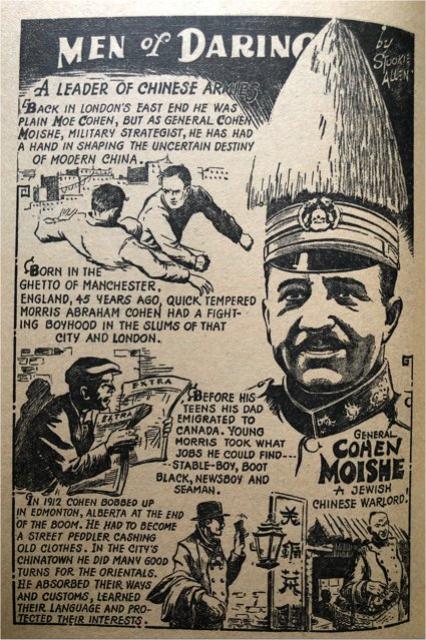Towards an Heroic Image
Michael Alderton (essarem) notes: The above is the opening page of the earliest graphic depiction of General Cohen’s life story, which was drawn by Stookie Allen and published by Argosy magazine in New York during January 1934. It is titled Men of Daring (True Story in Pictures) Gen. Cohen Moishe, leader of Chinese armies, and forms part of the Men of Daring series - one or two page weekly picture stories depicting famous individuals, created and drawn by Stookie Allen. Benjamin ‘Stookie’ Allen (1903-1971) was a U.S. cartoonist, who specialized in nonfiction, heroic and inspirational characters. Stookie Allen’s visualization of General Cohen’s life story reflects what had recently been published in U.S. newspaper feature articles, and it contains some degree of speculation regarding the subject’s early life. When visiting the U.S. at this time, the General was quick to disclaim published reports that he used to be a clothes pedlar and later a cowboy, cheerfully offering ‘to shoot the man who can prove it.’ General Cohen’s own take on his life story was far more pared back and considered, preferring to talk more of the present than on his past. When asked about his exciting experiences in China since the death of Dr Sun Yat-sen, the uncooperative General merely shrugged his shoulders, and steered the conversation towards discussions of ‘the new China’. General Cohen did, however, reveal that: ‘I was born in London, and lived for many years in Canada, where I first met Dr Sun Yat-sen. During the war I went to France with the Canadian forces, and, after demobilization, went to China at the request of the famous leader, joining his staff as A.D.C. I am now (1933) a military organizer in the Cantonese forces, acting as liaison officer between the Southern Government and the Foreign Powers.’ When pressed for more information about his life and adventures, the reluctant General’s somewhat dismissive response was to modestly concede the fact that: ‘a great deal has been written about me, including my obituary!’ Stookie Allen’s early, graphic depiction of General Cohen’s life story reflects what was popularly believed to be true at the time, and is certainly not completely without merit. In this reader’s opinion, some of the more revealing pieces of text accompanying the graphics can be edited and presented as follows: “A Leader of Chinese Armies. Back in London’s East End he was plain Moe Cohen, but as General Cohen Moishe, military strategist, he has had a hand in shaping the uncertain destiny of modern China. When the World War started, Cohen enlisted in a Canadian contingent and was made senior sergeant in charge of Chinese labourers building railroads back of the lines, which was just as risky as combat service. After the war, Cohen was sought as business advisor by Chinese in Edmonton, Canada. He became the only white member of the Kuo Min Tang in Western Canada. In 1922 he travelled to China and joined Dr Sun Yat-sen, father of the modern Chinese republic, as his personal bodyguard. Cohen became a power behind the scenes. He helped train the Cantonese forces along modern lines. He handled the finances of the Nationalists, and strove to bring about Chinese unity. He was in continual danger of attacks by assassins. When Japan’s military expansion in 1932 brought hostilities to Greater Shanghai, Gen. Cohen’s crafty defensive fighting played a role in the valiant defence of the Chinese city by Chinese troops.”
